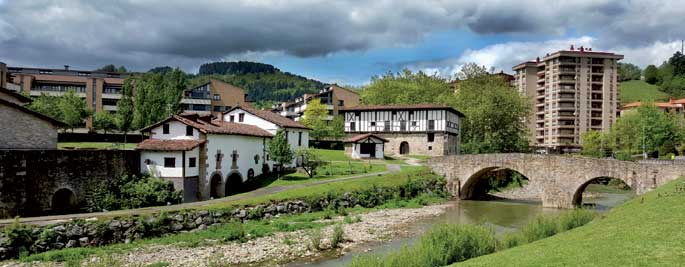Monumental Complex of Igartza, for the people and the people
- Igartza is much more than a set of Monuments of the Middle Ages: a strategic point for trade, cradle of iron export to Europe, step between agriculture and industry… Since time immemorial it has been a turning point in local socio-economic development and a point of access to multiple innovations. In addition to being a historical and archaeological space, the high is a space with many functions recovered for the people and the citizens.

The Igartza de Beasain Monumental Complex offers an excellent opportunity to understand what has happened. The bridge, the road, the lagar, the hermitage, the ferreria and the mill that are embraced at the height of the elegant medieval palace. Today they have a great historical and archaeological value, but at one time they were cutting-edge and innovative resources and were of great importance in the development of the local socio-economy.
So far, as a space that has been able to seamlessly combine tradition and innovation, the present and the history of Beasaindarras fall into the same picture. Since the City of Beasain began the recovery of Igartza with the Provincial Council of Gipuzkoa and the Society of Aranzadi Sciences, there are few cultural and folkloric manifestations that the Beasaindarras have placed and breathed in this space.
Not only that, but in addition to the acts mentioned, there are all kinds of talks, meetings, representations, workshops, guided tours, weddings, civil funerals, etc.
Reflection of the social revolution
In these centuries Igartza has been of everything: crossroads, passageways, connections, engine of growth, strategic center for war and trade... The main route linking the Alavesa plain with the Basque coast was the passage through the Igartza Bridge. In this sense, about 800 years ago the first tower and the Igartza bridge were built, on the orders of Mr. de Lazkao to his second son García López, to control the whole environment.
In the mid-thirteenth century, Agurain, Segura, Tolosa and Ordizia, upon obtaining the competence of villa and becoming legally constituted, created new councils or organs of power. The election of the members of these bodies was made among the citizens, which resulted in a social revolution.
In the words of Juantxo Agirre Mauleón, a member of the Society of Sciences Aranzadi, “Igartza is a reflection of the political conflict between lords and peasants, where the peasants demolished the towers of the caciques that believed to be above them”.
The only witness to wood engineering in Europe
The transportation of goods from Castile in 1200, since the conquest of the valleys of Gipuzkoa, the Duranguesado and the lands of Álava by the Kingdom of Castile, became increasingly important through these territories.
In 1611, Mrs. de Igartza Isabel Lobiano built a hostel next to the road, the current Hotel Dolarea. The current stone bridge is an heir to which it was built at that time. The hermitage of Bethlehem is also believed to be between the 16th and 17th centuries, but there is no written evidence of it.
The present Igartza Palace is after 1520, but presents remains two centuries later. The wooden patio that welcomes you upon entering is one of the few exponents of this type of architecture throughout the Basque Country. However, there is another gem on the ground floor of the palace: The only witness to the wood engineering displayed throughout Europe. The dam of 1568, which was restored in 2011 by the Albaola Maritime Heritage Association.
The three buildings that make up the mill are also of great value. By 1504 it was collected that it had three pairs of stones to grind. However, the current main building dates from 1740. Next to it is the housing of the moliners, which is currently the hostel of the Camino de Santiago, and a little further behind the electric turbine room.
Although the first writings on ferreria date back to the 15th century, they had to be completely renovated. The current building (1782) is one of the best examples of hydraulic mills built in the Enlightenment era. As a result, the Basques began exporting iron across Europe from the minerals of Zerain and Mutiloa. In 1860, the San Martin Irons Factory was created, the first high furnace of Gipuzkoa, after descending the Ferrones River of Igartza. It is the origin of the current CAF.
Igartza has so far been a source of very varied waters and seems to have a flow of a certain length. Beasain recovers Igartza and Beasaindarra Igartza, therefore, puts at the service of the citizenship to which it was the cacique of then, becoming the active center of the city.
Beasaindik Bergararako tartea hamar minututan egiteko aukera ematen du 2019an zabaldu zuten A-636 errepide berriak, eta Gipuzkoako Deba bailara eta Goierri eskualdeak Nafarroa, Araba eta Bizkaiarekin lotzen ditu. Bidesaria jarri berri dute orain eta askotariko albo-kalteak... [+]
Elkarretaratzera deitu du goizean Beasainen Goierriko Kontseilu Sozialistak, eta dozenaka lagun elkartu dira etxegabetze arriskuan zeuden emakumeari eta bere hiru seme-alabei babesa ematera. Gutxienez beste astebetez geratu ahal izango dira etxean, etxejabearekin lortutako... [+]
Urtarrilaren 18an sartuko da indarrean Beasain eta Bergara arteko errepideko bidesari berria, eta Goierriko eta Deba Bailarako Kontseilu Sozialistek azaroan jarri zuten martxan neurriaren aurkako dinamika bat. Igandean, hain justu, ehunka lagun elkartu ziren Beasainen,... [+]
























